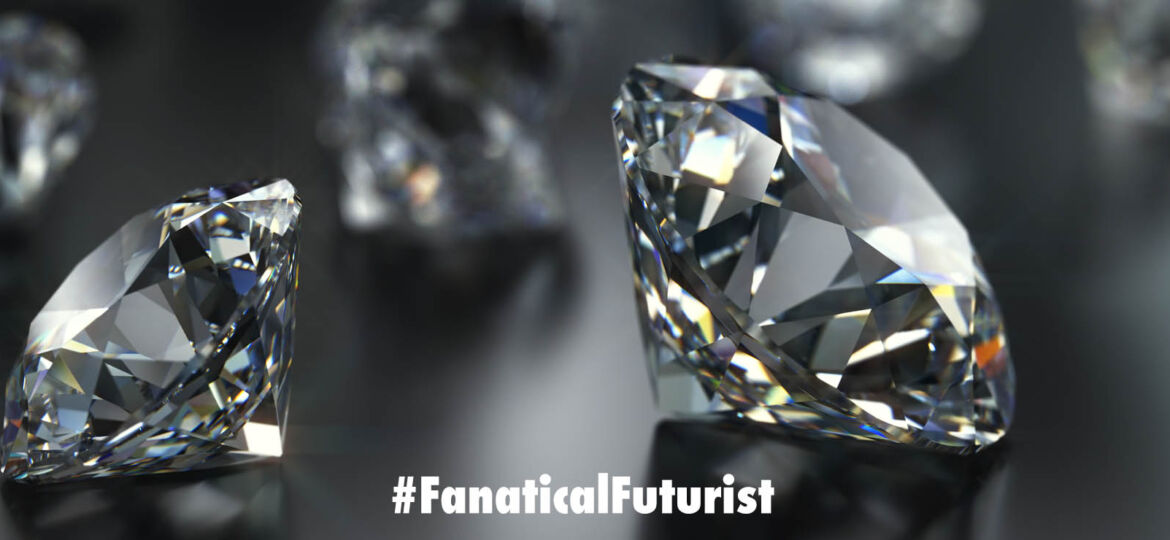
WHY THIS MATTERS IN BRIEF
Moore’s Law is slowing, because of both commercial and technical reasons, but diamonds are a semi-conductor company’s best friends …
 Love the Exponential Future? Join our XPotential Community, future proof yourself with courses from XPotential University, read about exponential tech and trends, connect, watch a keynote, or browse my blog.
Love the Exponential Future? Join our XPotential Community, future proof yourself with courses from XPotential University, read about exponential tech and trends, connect, watch a keynote, or browse my blog.
As we continue to see huge breakthroughs in being able to make lab made diamonds from nothing but air – even giant 45 Carat pieces of jewellery – Adam Khan, the founder and chairman of Akhan Semiconductor, expects diamond to be just one of the materials that will help take diamond based quantum computers and semiconductors beyond the Moore’s Law era, which recently has been slowing as companies like Intel and TMSC find it increasingly commercially and technically challenging to keep pace with as transistor sizes start falling below 3nm.
In 2014, the US Department of Energy’s Argonne National Laboratory announced an intellectual property licensing agreement with Akhan, in a public-private partnership aimed at commercializing diamond-based semiconductor technologies. Now, today with a strong patent portfolio and a pilot facility for chemical vapor deposition of diamond on silicon wafers, the company aims to be first to test a technology that promises to make enforcement of Moore’s Law less urgent.
“There’s sort of two camps, right?” Khan said in an interview with CNN. “There’s the Moore’s Law, the More-Than-Moore’s Law group, right? And then there’s the What-Comes-Next group.”
The next advanced semiconductor materials will need to solve issues like power levels and lithography, according to Khan. As transistor densities increase on a chip, there’s been a need to add multi-layer materials as a thermal management layer to reduce heating on the top, as well as growing problems like parasitic losses. The limitations of silicon in terms of efficiency and performance tradeoffs have turned attention to packaging because of thermal issues.
But besides packaging, Akhan is looking at diamond as a semiconductor material that may someday replace silicon.
“Not only is diamond the highest thermal-conductance material, but it dissipates heat better than any other 3D material we know, and thus, integrating it solves a lot of the heating issues and the thermal shock issue of semiconductor electronics,” Khan says. “Diamond is also the best in terms of the wide bandgap materials.”
Wide-bandgap (WBG) semiconductors operate at higher voltages, frequencies and temperatures than conventional materials like silicon and gallium arsenide. WBGs are used in some radio-frequency applications, including military radars. WBGs are poised for adoption in a wider range of applications, especially in next-generation electronic devices.
The widespread use of diamond as a semiconductor material should not require any major changes in the current chipmaking process, according to Khan.
“The only additional tool that would need to be inserted into the foundry line or into the process itself would be the actual diamond Chemical Vapor Deposition (CVD) tool.” Otherwise, the process includes “all of the normative semiconductor and metrology equipment that you would use, which we have running in a pilot facility.”
Not far from the Argonne Laboratory in northern Illinois, Akhan operates its so-called “diamond mine,” where it is running diamond CVD processes.
Customers can contract low to medium volume production out to Akhan and its 25 employees, but at the highest volume, the company is prepared for licensing and equipment sales to chipmakers.
“A customer would license our process and then bring the tool in-house to insert into their own fab,” Khan says.
Diamond’s cooling capability is five times that of copper and more than 20 times that of silicon, according to Khan.
“During operation, the temperatures on these devices now drop largely to room temperature, depending on the type of material you’re running and the thickness of the underlying material. But we have substantial reductions in terms of the thermal budget during operating temperatures.”
Akhan’s technology is also used in optics, display glass, and computer chips for customers that Khan identifies as Lockheed Martin and Honeywell. A “rather large smartphone OEM” that Khan is unwilling to name is also a customer as well as other companies in semiconductor equipment and end consumers in aerospace and defense.
With the Argonne National Laboratory, Akhan made what Khan calls “two major breakthroughs”. One was low-temperature deposition of diamond at CMOS-compatible temperatures. The partners also enabled a new co-doping technique in diamond for power and logic-based electronics. From there, Akhan grew innovations into some 40 plus patents worldwide, covering various applications in optics, display glass, and semiconductors.
There are certainly other companies in the diamond space, Khan says. He gives one example, Diamond Foundry, which is making lab-grown gem material and has a reported market valuation of about $1.8 billion. Diamond Foundry mainly makes high-end luxury diamonds for jewellery.
















